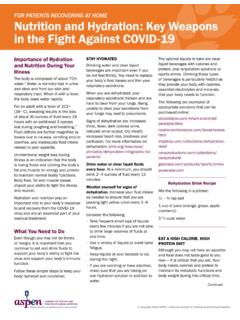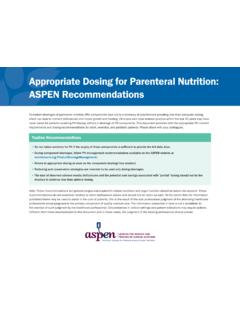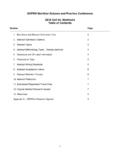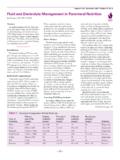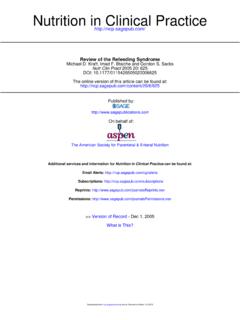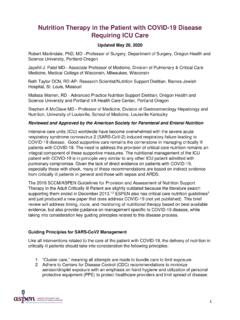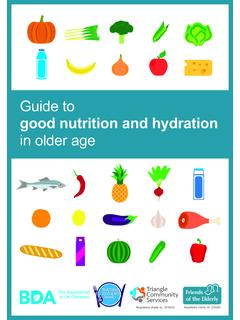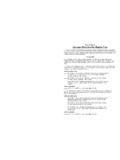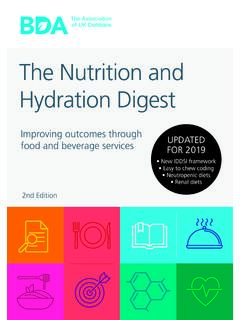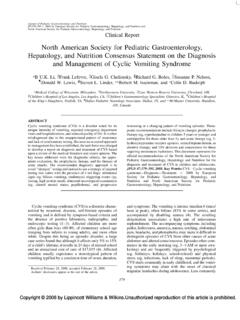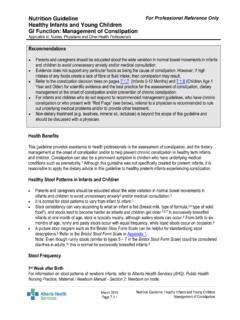Transcription of Support Line December 2005 Volume 27 No. 6 Fluid and ...
1 Support Line December 2005 Volume 27 No. 6. Fluid and Electrolyte Management in Parenteral nutrition Jodi Kingley, MS, RD, CNSD Writer's Mentoring Program Abstract Plasma proteins maintain plasma and oxidation of protein, carbohy- An understanding of basic Fluid and Volume primarily through oncotic drate, and fats yields approximately electrolyte physiology can aid clinicians pressure (1). In response to changes 300 mL water. Fluid output consists of in administering parenteral nutrition in solute concentrations, water passes losses from urine (1,200 to 1,500 mL). (PN). Disturbances in electrolytes, Fluid , throughout these compartments to and stool (~100 to 200 mL) (4). Other and acid-base balance require changes maintain osmotic equilibrium (1). output is termed insensible because it in therapy.
2 Therefore, close monitoring cannot be measured, but it has been Water Balance of these parameters is essential during estimated that the average adult loses Maintaining an appropriate water 450 mL of Fluid per day (5). the administration of PN. balance is crucial for optimal metabolic During illness, there are multiple other function. Thirst, antidiuretic hormone sources of input and output, including Introduction (ADH), and aldosterone regulate water intravenous (IV) fluids, medications, and balance. During periods of acute illness, drips. IV medications and drips should Parenteral nutrition (PN) is a com- ADH and aldosterone production are be subtracted from estimated Fluid plex therapy containing more than 40 often increased. Hypotension, stress, requirements before calculating the components, including dextrose, amino decreased intravascular Volume , pain, PN formulation.
3 Variables for output acids, fat emulsions, water, electrolytes, surgery, and increased plasma osmolality include nasogastric suctioning losses/. trace elements, and vitamins. To order all increase ADH output, favoring vomiting, diarrhea, fistula drainage (4), PN appropriately, clinicians must have water retention. Aldosterone production and sequestration of fluids resulting a good understanding of body compo- increases when kidney perfusion from injury, infection, peritonitis, and sition, Fluid balance, electrolyte assess- decreases, causing sodium and water burns (6). Such losses must be replaced ment, and acid-base balance. retention (1). An aging individual, to prevent Fluid deficits. When accounting Body Fluid Compartments generally defined as older than 65 for significant losses from the gastro- years, has a diminished ability intestinal tract, it is important to have Total body water (TBW) comprises to adjust to hemodynamic changes a general understanding of the amounts approximately 60% of body weight in compared with a younger person.
4 Of electrolytes lost that require replace- men and 50% in women. There are Therefore, in a hospitalized, acutely ment (Table 1) (4). The PN solution two primary compartments of water in ill elderly patient, extra care must be can be adjusted to provide for these the body. Intracellular Fluid Volume taken with total Fluid provision, Fluid ongoing electrolyte losses. (ICFV) contains two thirds of TBW, balance, and monitoring of serum Insensible losses occur primarily and extracellular Fluid Volume (ECFV) chemistry values (2). with fever; Fluid needs increase contains the remaining one third (1). Assessing Fluid Requirements with each degree increase in body The ECFV contains interstitial Fluid temperature greater than 37 C (4) or and plasma. Interstitial Fluid surrounds An average adult requires approxi- approximately 60 to 80 mL daily for cells and comprises three quarters of mately 2,000 to 2,500 mL/d of water (3).
5 Each degree over normal ( F) (2). the ECFV Volume . Plasma makes up Oral fluids provide 1,100 to 1,400 mL;. the remaining one quarter of ECFV. solid foods provide 800 to 1,000 mL; (Continued on page 16). Table 1. Electrolyte Composition of Body Fluids (6). Volume Sodium Potassium Chloride Bicarbonate Type of (mL/24 h) (mEq/L) (mEq/L) (mEq/L) (mEq/L). Secretion (range) (range) (range) (range) (range) Tonicity Saliva 1,000 30 to 80 20 70 30 Hypotonic Sweat 200 to 1,000 20 to 70 5 to 10 40 to 60 0 Hypotonic Stomach 1,000 to 2,000 60 to 80 15 100 0 Hypotonic Small bowel 2,000 to 5,000 140 20 100 25 to 50 Isotonic Colon 200 to 1,500 60 30 40 0 Hypotonic Bile 1,000 140 5 to 10 100 40 Isotonic Pancreas 1,000 140 5 to 10 60 to 90 40 to 110 Isotonic 13 . Support Line December 2005 Volume 27 No.
6 6. Increased insensible losses occur from or repletion of Fluid and electrolytes, interchangeable because the only dif- hyperventilation, low humidity, and especially sodium chloride and potas- ference between the two is blood urea increased ambient room temperature sium (Table 3). Some contain dextrose nitrogen, which is the smallest contrib- (4). Fluid requirements vary with age, as a protein-sparing source. IV fluids utor to plasma osmolality (Table 4). If sex, body weight, disease state, and are also used to provide IV antibiotics, plasma osmolality is normal (275 to degree of insensible loss. which are mixed in dextrose or normal 295 mOsm/kg), the hyponatremia is Table 2 lists several methods to saline (9). usually due to hyperlipidemia or determine Fluid requirements. Methods hyperproteinemia; this is rarely seen 1 and 3 should be used carefully because Electrolytes with modern laboratory assays.
7 If plasma they can result in insufficient Fluid Plasma electrolyte abnormalities are osmolality is high (>295 mOsm), the provision for those with low body common in acutely ill patients. The hyponatremia is likely due to hyper- weights and excess Fluid provision in nutrition Support clinician should glycemia or intravenous infusions of obese patients. Conversely, method 4 understand the factors that cause glucose or mannitol (4). The pseudo- (the Adequate Intake) is based on healthy irregular electrolyte levels because PN hyponatremia value should be corrected: individuals (5) and, therefore, may not is often the primary Fluid source for for every 100-mg/dL increase in be applicable during acute illness. The those receiving the therapy. PN fre- glucose, plasma sodium decreases literature suggests a minimum of quently is used to help correct such to 2 mEq/L (13).
8 1,500 mL/d of fluids for most elderly deficits or excesses, unless the patient If hypertonic and isotonic hypona- persons (7). Fluid restrictions may be is unstable. Separate IV administration tremia are ruled out, hypotonic required for those with cardiac, liver, of electrolytes is more practical for hyponatremia is present. This is the and renal disease. frequent changes in Volume and most common cause of hyponatremia electrolyte requirements (10). and requires assessment of the ECFV. Intravenous Fluids Hypotonic hyponatremia results from Sodium A basic understanding of IV solutions an excess of water in relation to exist- Evaluating abnormal sodium concen- and what they provide can assist when ing sodium stores and usually is due trations is not always straightforward. evaluating sodium, electrolyte, and to decreased renal water excretion.
9 Plasma sodium concentration is the Fluid provision in nutrition Support Complications of hypotonic hypona- primary measurement used to deter- regimens. IV fluids provide maintenance tremia are more severe when the mine the volumes of the ICF and ECF, decrease in serum sodium concentration not the actual amount of total body Table 2. Estimating Water is large or rapid (occurring over hours). sodium (11). Sodium is the main cation Requirements Most patients with serum sodium con- in the ECFV. If the total amount of centrations greater than 125 mEq/L. Method 1 (1) sodium in the ECFV is elevated, the are asymptomatic. If clinical symptoms 30 to 40 mL/kg size of the ECFV also increases, which occur, they include headache, nausea, may lead to a state of Volume overload. Method 2 (4) vomiting, muscle cramps, lethargy, Insufficient sodium in the ECFV.
10 1. 100 mL/kg for first 10 kg body disorientation, depressed reflexes, compartment results in Volume weight seizure, or coma (14). depletion (1). 2. 50 mL/kg for second 10 kg Sodium stores can be decreased, body weight Hyponatremia normal, or increased with hypotonic 3. For age <50 y: 20 mL/kg for Hyponatremia is defined as a serum hyponatremia. The associated condi- each additional kg body weight sodium concentration of less than tions are usually termed hypovolemic, 4. For age >50 y: 15 mL/kg for 135 mEq/L. The mortality of patients isovolemic, and hypervolemic hypona- each additional kg body weight with hyponatremia is approximately tremia (4,8). double that of patients with normal Hypovolemic hyponatremia occurs Method 3 (4) plasma sodium concentrations (11). It is with renal and/or extrarenal sodium 16 to 30 y, active: 40 mL/kg also the most common electrolyte dis- losses.
